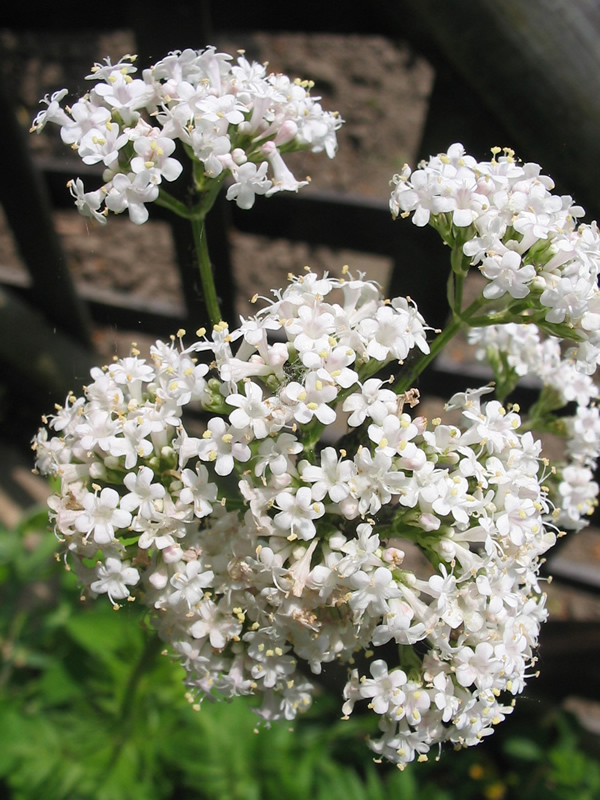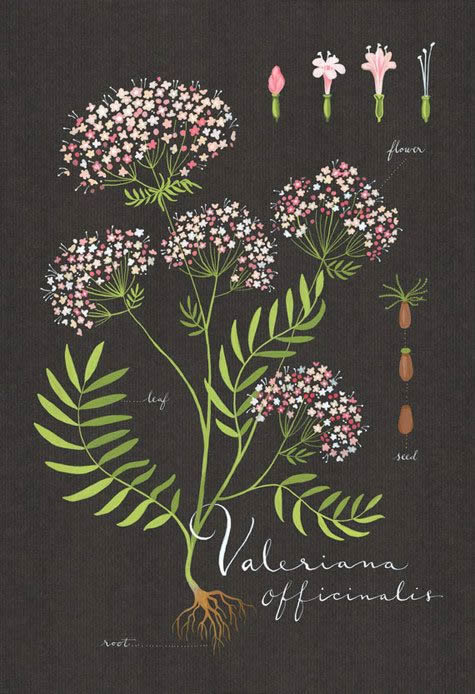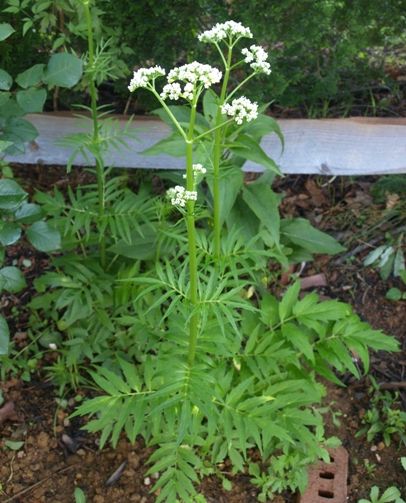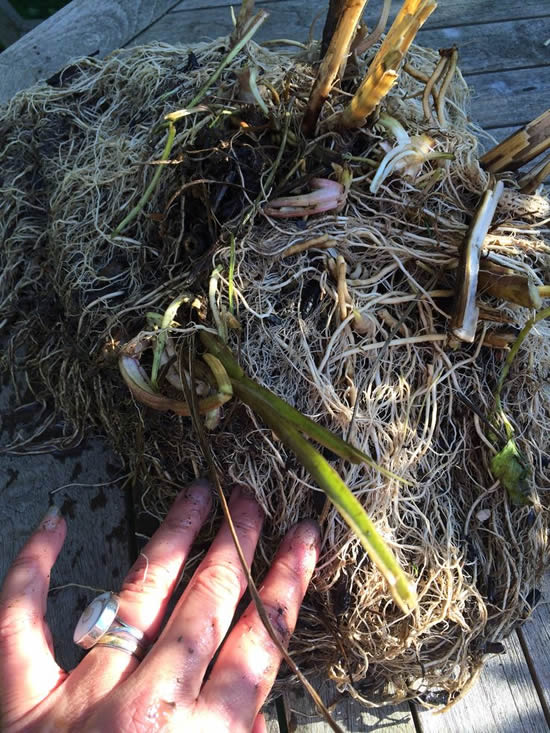 |
| Valerian (Valeriana officinalis) |
Valerian (Valeriana officinalis) is one of about 200 members of the Valerianaceae family. This plant is native to Europe and west Asia; it is naturalized throughout North America.
A common name for this hardy perennial is garden heliotrope. Valerian has been valued for its soothing qualities for at least a millennium. The name valerian may have come from the Latin valere meaning “to be strong” or “to be in good health.” Chaucer called the herb setewale.
Other common names include all-heal, vandal root, and Capon’s tail. The Greek doctor Galen called a particularly odorous species of valerian “phu,” referring to the distinctively unpleasant smell of the dried root. The strong odor appeals to earthworms, intoxicates cats, and attracts rats.
  |
According to legend, the Pied Piper of Hamlin, with the assistance of the odorous valerian root, lured the town’s rats to the river to drown. Some Asian species of valerian have a more pleasant aroma and may have included spikenard (the biblical name for valerian), which was known as a perfume from the East.
In ancient times, valerian was believed to be under the influence of the god Mercury. The herb grows in lime-rich soil near streams, or in damp, low meadows where it may reach a height of 5 ft (1.5 m). It is also found in drier environments at higher elevations, where it grows to just 2 ft (0.6 m). Roots harvested from the drier environment may be more medicinally potent. This variety is sometimes known as sylvestus.
 |
| valerian (picture) |
Valerian’s short vertical rhizome is dark yellow-brown in color and has round rootlets. These rootlets produce hollow, fluted stems with opposite leaves and a single leaflet at the tip, and as many as eight to 10 pairs of toothed leaflets.
The upper leaves are attached at their base and emerge from a white sheath along the stem. The stems remain erect and unbranched until the very top, were the small, white flowers, tinged with pink, bloom in clusters in the middle of summer. Seeds are winged with tufts of white hair, and they scatter on the wind.
General use
As of 2003, researchers have identified some of the active ingredients in valerian that are responsible for its medicinal properties. A team of pharmacologists in Argentina reported in the spring of 2003 that they had isolated two new flavonoids, 6-methylapigenin and hesperidin, as compounds with sedative and sleep-enhancing properties.
In addition to these flavonoids, valerian contains volatile oil, valepotriates, glycosides, alkaloids, choline, tannins, and resins. Valerian’s rhizome and root are the medicinal part of this herb. Fresh root will produce the highest quality of medicinal extract.
 |
| Valerian whole plant |
Valerian acts as a pain reliever, antispasmodic, sedative, carminative, and can help support nerve tissue. A British study published in 2002 suggests that valerian’s effectiveness in relieving stress is related to its ability to lower the body’s reactivity in stressful situations. Valerian can also help to promote menstrual flow. As a natural tranquilizer, valerian can soothe anxiety, nervous tension, insomnia, and headache.
It acts on the peripheral nerves and relaxes both the smooth and skeletal muscle tissue to reduce tension. It also strengthens the heart and provides relief from menstrual cramps, stomach cramps, irritable bowel, and upset stomach caused by nerves.
Valerian has also been shown to lower blood pressure. One study found that valerian tends to sedate the agitated person and stimulate the fatigued person, bringing about a balancing effect on the system. Externally, a lotion prepared with valerian extract will ease irritation of skin rashes and soothe swollen joints.
The plant has been used as a medicinal herb for more than a thousand years, especially for mild cases of insomnia. Research shows that proper use of valerian promotes sleep, reduces night awakenings, and increases dream recall in most people. Historically, valerian has been highly regarded as a tranquilizer that acts without narcotic effects.
It is particularly popular with women; a recently introduced herbal formula for menopausal women contains valerian along with hops and black cohosh as an active ingredient. The herb has also been used to treat illnesses as diverse as epilepsy and the plague. In the sixteenth century, valerian was reported to have cured a case of epilepsy.
It was also used to treat hysteria, migraine, and vertigo. Culpeper recommended the herb for “driving away splinters or thorns from the flesh.” Valerian was listed in the United States Pharmacopoeia from the early seventeenth century until the mid-twentieth century.
During World War I, soldiers traumatized by the constant bombing and those suffering from “shell shock” were treated with valerian. The herb was listed in the U.S. National Formulary until 1950, and continues to be listed in the official pharmacopoeias of Germany, Belgium, and France.
More recently, valerian is being studied as a possible chemopreventive for cancer. Further research is necessary, however, to determine its effectiveness in this regard.
Preparations
 |
| Valerian root |
Valerian root should be harvested in the autumn of its second year. Valerian works well in combination with other tranquilizing herbs such as passionflower (Passiflora incarnata) to safely induce sleep, or skullcap (Scutellaria laterifolia) to relieve nervous tension.
The somewhat bitter, unpleasant taste of the tea may be masked by adding peppermint oil, or the user can take the herb in capsule form. Combinations contain equal parts of each herb. The herb may be drunk as an herbal tea, used as a tincture, or swallowed in capsule form one hour before bedtime.
Precautions
Valerian should not be used in large doses or for an extended period. People should not take it continuously for more than two to three weeks. Users of valerian may become tolerant to its effects with prolonged use.
Increasing the dose of the herb to achieve desired effects may result in negative side effects. Prolonged use, according to some research, could result in liver damage and central nervous system impairment.
Side effects
Large doses of valerian may occasionally cause headache, muscle spasm, heart palpitations, dizziness, gastric distress, sleeplessness, and confusion. Uninterrupted use may cause depression.
Interactions
Although valerian has been regarded as a relatively safe herb because few interactions with prescription medications have been reported, newer research indicates that it should be used cautiously following surgery. Like St. Johnís wort, valerian can interact with anesthetics and other medications given to patients after surgery.
Because valerian has a mild sedative effect, it should not be taken together with alcoholic beverages, benzodiazepines, barbiturates, or antihistamines. Long-term safety studies of valerian have not been done as of early 2003.
Iklan
 |
| Valerian (Valeriana officinalis) |
Valerian (Valeriana officinalis) is one of about 200 members of the Valerianaceae family. This plant is native to Europe and west Asia; it is naturalized throughout North America.
A common name for this hardy perennial is garden heliotrope. Valerian has been valued for its soothing qualities for at least a millennium. The name valerian may have come from the Latin valere meaning “to be strong” or “to be in good health.” Chaucer called the herb setewale.
Other common names include all-heal, vandal root, and Capon’s tail. The Greek doctor Galen called a particularly odorous species of valerian “phu,” referring to the distinctively unpleasant smell of the dried root. The strong odor appeals to earthworms, intoxicates cats, and attracts rats.
  |
According to legend, the Pied Piper of Hamlin, with the assistance of the odorous valerian root, lured the town’s rats to the river to drown. Some Asian species of valerian have a more pleasant aroma and may have included spikenard (the biblical name for valerian), which was known as a perfume from the East.
In ancient times, valerian was believed to be under the influence of the god Mercury. The herb grows in lime-rich soil near streams, or in damp, low meadows where it may reach a height of 5 ft (1.5 m). It is also found in drier environments at higher elevations, where it grows to just 2 ft (0.6 m). Roots harvested from the drier environment may be more medicinally potent. This variety is sometimes known as sylvestus.
 |
| valerian (picture) |
Valerian’s short vertical rhizome is dark yellow-brown in color and has round rootlets. These rootlets produce hollow, fluted stems with opposite leaves and a single leaflet at the tip, and as many as eight to 10 pairs of toothed leaflets.
The upper leaves are attached at their base and emerge from a white sheath along the stem. The stems remain erect and unbranched until the very top, were the small, white flowers, tinged with pink, bloom in clusters in the middle of summer. Seeds are winged with tufts of white hair, and they scatter on the wind.
General use
As of 2003, researchers have identified some of the active ingredients in valerian that are responsible for its medicinal properties. A team of pharmacologists in Argentina reported in the spring of 2003 that they had isolated two new flavonoids, 6-methylapigenin and hesperidin, as compounds with sedative and sleep-enhancing properties.
In addition to these flavonoids, valerian contains volatile oil, valepotriates, glycosides, alkaloids, choline, tannins, and resins. Valerian’s rhizome and root are the medicinal part of this herb. Fresh root will produce the highest quality of medicinal extract.
 |
| Valerian whole plant |
Valerian acts as a pain reliever, antispasmodic, sedative, carminative, and can help support nerve tissue. A British study published in 2002 suggests that valerian’s effectiveness in relieving stress is related to its ability to lower the body’s reactivity in stressful situations. Valerian can also help to promote menstrual flow. As a natural tranquilizer, valerian can soothe anxiety, nervous tension, insomnia, and headache.
It acts on the peripheral nerves and relaxes both the smooth and skeletal muscle tissue to reduce tension. It also strengthens the heart and provides relief from menstrual cramps, stomach cramps, irritable bowel, and upset stomach caused by nerves.
Valerian has also been shown to lower blood pressure. One study found that valerian tends to sedate the agitated person and stimulate the fatigued person, bringing about a balancing effect on the system. Externally, a lotion prepared with valerian extract will ease irritation of skin rashes and soothe swollen joints.
The plant has been used as a medicinal herb for more than a thousand years, especially for mild cases of insomnia. Research shows that proper use of valerian promotes sleep, reduces night awakenings, and increases dream recall in most people. Historically, valerian has been highly regarded as a tranquilizer that acts without narcotic effects.
It is particularly popular with women; a recently introduced herbal formula for menopausal women contains valerian along with hops and black cohosh as an active ingredient. The herb has also been used to treat illnesses as diverse as epilepsy and the plague. In the sixteenth century, valerian was reported to have cured a case of epilepsy.
It was also used to treat hysteria, migraine, and vertigo. Culpeper recommended the herb for “driving away splinters or thorns from the flesh.” Valerian was listed in the United States Pharmacopoeia from the early seventeenth century until the mid-twentieth century.
During World War I, soldiers traumatized by the constant bombing and those suffering from “shell shock” were treated with valerian. The herb was listed in the U.S. National Formulary until 1950, and continues to be listed in the official pharmacopoeias of Germany, Belgium, and France.
More recently, valerian is being studied as a possible chemopreventive for cancer. Further research is necessary, however, to determine its effectiveness in this regard.
Preparations
 |
| Valerian root |
Valerian root should be harvested in the autumn of its second year. Valerian works well in combination with other tranquilizing herbs such as passionflower (Passiflora incarnata) to safely induce sleep, or skullcap (Scutellaria laterifolia) to relieve nervous tension.
The somewhat bitter, unpleasant taste of the tea may be masked by adding peppermint oil, or the user can take the herb in capsule form. Combinations contain equal parts of each herb. The herb may be drunk as an herbal tea, used as a tincture, or swallowed in capsule form one hour before bedtime.
Precautions
Valerian should not be used in large doses or for an extended period. People should not take it continuously for more than two to three weeks. Users of valerian may become tolerant to its effects with prolonged use.
Increasing the dose of the herb to achieve desired effects may result in negative side effects. Prolonged use, according to some research, could result in liver damage and central nervous system impairment.
Side effects
Large doses of valerian may occasionally cause headache, muscle spasm, heart palpitations, dizziness, gastric distress, sleeplessness, and confusion. Uninterrupted use may cause depression.
Interactions
Although valerian has been regarded as a relatively safe herb because few interactions with prescription medications have been reported, newer research indicates that it should be used cautiously following surgery. Like St. Johnís wort, valerian can interact with anesthetics and other medications given to patients after surgery.
Because valerian has a mild sedative effect, it should not be taken together with alcoholic beverages, benzodiazepines, barbiturates, or antihistamines. Long-term safety studies of valerian have not been done as of early 2003.

Post a Comment